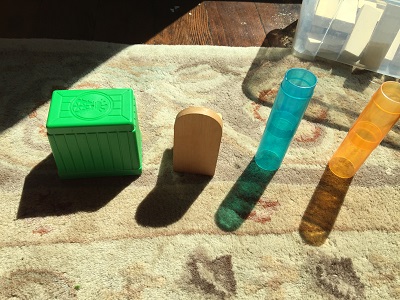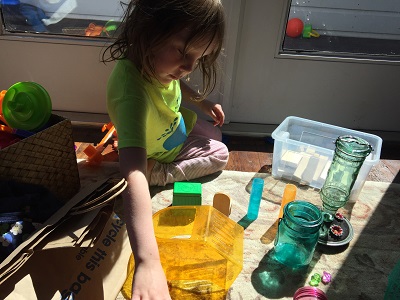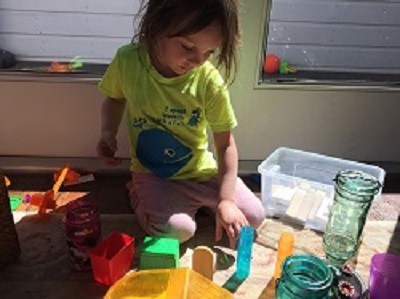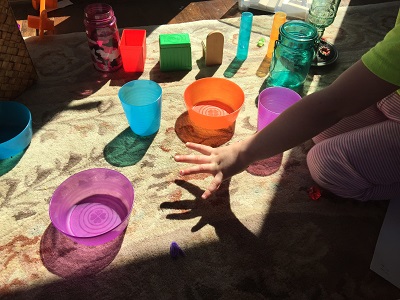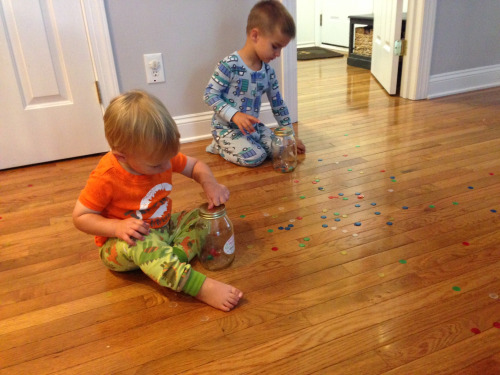The holidays are upon us once again. With small children around us, many of us have a renewed magical holiday spirit about us. The holidays can be a wonderful time to share family traditions, create new rituals, and enjoy extended quality time with friends and family alike. Of course the holidays can also bring a tangible feeling of stress, and sometimes the desire to give our children the “perfect holiday season” can only add to this stress, and probably doesn’t end up feeling so magical for our children in the end. I have learned (through trial and error) that sticking to simple activities like making cookies at home with a few friends, caroling with neighbors, or driving around to look at Christmas lights, are the things that my children remember the most fondly. We try to limit our big holiday events to one or two things like visiting the life size gingerbread house at the Fairmont, or riding on a cable car. Keeping in mind their bed times as much as possible, we have learned to schedule these things earlier and earlier in the evening to reduce the holiday fatigue syndrome for our little ones.
With all of these Holiday moments also comes comes the question… what to get our children? There is the temptation to go overboard in attempt to give them a magical, unforgettable day, forgetting that for our youngest children they are probably completely content with 1 or 2 well-chosen gifts. Before you and your children become heavily laden with a mountain of toy clutter that you might not want in your house after January arrives and the initial joy has worn off, we encourage you to take some time to consider what items will bring the most meaningful use to your child throughout the coming year(s). Buying with intention will help ensure that items are well loved, used, and cherished, and actually teaches children to value, be grateful for (and play with!) their toys so much more.
In last year’s toy list (also a great reference for this year), we focused on helping you envision creating a home play space with intention, shopping like a preschool teacher, and engaging your children in various areas of play. With these same concepts in mind we have added a several new favorites! Gifts that are open ended in nature and inspire imagination and creativity, gifts that get out some of that abundant energy, and gifts that inspire dramatic play are at the top of our list this year. We have also added an “experience” section, particularly helpful for well-meaning grandparents and other relatives to consider giving a museum or zoo memberships as well as special outings and quality time that will literally “keep giving” the whole year through!
Onto the toys… Our suggestions are broken into categories and include items that are made to last, both in materials and across age ranges. Most of these (Magnatiles, Jungle Jumparoo, forts, sturdy blocks, etc.) are things your children can use for years. Each category fits particular interests and making sure your child has a balance of elements in each category in their play space will help expand their play.
As you make careful, conscious shopping decisions, please remember to shop locally when possible. Many of the links below are reference suggestions. Some of our favorite local shops include Recess, Green Apple Books, West Portal’s 3 toy stores, and, of course, consignment shops like Chloe’s Closet. We also highly recommend reducing your family’s carbon foot printby buying secondhand from parent listervs, Craigslist, school rummage sales, neighborhood parenting pages on Facebook, etc. Not only is it greener to shop local and second hand, but it’s also a great way to connect with like-minded parents around you, help out folks in your community, and of course reduce the stress of the financial burden of the holidays.
Blocks & Manipulatives
All Ages:
Magna Tiles: If you haven’t discovered these yet, let me be the first to introduce you to what will likely lead to hours of engaged, happy, creative children! These colorful tiles will hold a child’s interest well into elementary school. If you got your first collection last year, consideradding another set as children can certainly construct new and different things with a bigger selection. You can also add a “wheels” set!
Light Table: To add extra fun to your Magnatiles, and life in general, a Light Table is absolutely amazing. This is definitely an item that will grow with your child. Its uses are endless. You can use clear shapes to teach counting, enjoy sorting activities, and have fun with tracing.
Floor Blocks-perhaps you started your block collection last year? You may consider expanding or adding a collection of floor blocks which are still going strong in my house for my 7 year old! A great thing to try to find second hand, but if you have to buy new, this is probably the most reasonably priced.
http://www6.discountschoolsupply.com/Product/ProductDetail.aspx?product=21934&Category=
Toddlers (Up to 36 Months)
Balls-a good collection of indoor soft balls to help redirect the toddler throwing stage, as well as some balls to bring along to the park!
Scarves- store bought or a thrift store collection to encourage dancing, imagining and moving in creative ways.
Play Tunnel
Three and Up:
A great stacker for little ones to learn their colors and manipulate objects are Lakeshore Learning’s Crystal Climbers. This pairs perfectly with a light table.
Design & Drill: This drill can hold the attention of a little one for hours on end. The mechanical drill allows them to put colorful screws into a peg board and reverses to take them out again. This is great for color patterns. It comes with suggested patterns, or your child can create their own picture.
Wooden Dominoes: Endless sorting, stacking, and fun domino runs! Click here.
Marble Run: Children can create their own marble run and learn about cause and effect by testing their design to see if their marbles make it through to the end. There are also suggested designs with varying levels of building difficulty.
Fantacolor Junior Pegboard
Tinkertoys
CitiBlocs/ Keva planks
Castle Blocks
Discovery Ramps: For those budding engineers, a great way to learn about force, motion, and gravity. http://kodokids.com/discovery-ramps
Dramatic Play
Fort Magic/Fort Builder – Children love forts! They are a safe place to hide, help them feel powerful, and create plenty of opportunity for imagination. Fort kits, such as Fort Magic https://fortmagicstore.com/ provide the basic building tools to provide structure for unlimited possibilities.Costumes
Playmobil
Dolls
Arts & Crafts
Foam Rollers & No-Spill Paint Cups
Magnet Board: Can be homemade (framed metal sheet). IKEA has a great one.
Clay, Clay Tools, Wooden Hammers
Water Paper: Paint it, let it dry, paint it again. Reusable and wonderful! http://kodokids.com/water-paper
Active Play/Gross Motor:
Jungle Jumparoo: By far one of the coolest toys around. This looks like it would be ideal for a backyard setting, but is an amazing indoor addition. It doesn’t take up a ton of space and is a safe, fun way for toddlers and preschoolers to get their energy out. You can also attach a swing to the top for added fun.
Hoppity Hops
Monster Feet: https://www.amazon.com/Toysmith-2708-Monster-Feet/dp/B001E6IQP0/ref=sr_1_1?ie=UTF8&qid=1480606649&sr=8-1&keywords=monster+feet
Balance Board: https://www.amazon.com/ALEX-Toys-Active-Monkey-Balance/dp/B000N40SDC/ref=pd_sim_21_1?_encoding=UTF8&pd_rd_i=B000N40SDC&pd_rd_r=KEXZHPAD5CXYHRQ1MPVA&pd_rd_w=DsLFc&pd_rd_wg=AA6mM&psc=1&refRID=KEXZHPAD5CXYHRQ1MPVA
Bop It Bag
Climbing Dome: For those of you with outdoor space, this is a great investment. Children from 3 up to pre-teens will benefit from a geometric climbing dome. Add to the fun by attaching a swing or spinner to the top. Another great idea is to get magnetic letters to put on the sides and do a “word hunt” with older preschoolers. Climbing to the top and searching for letters adds to the adventure.
Gorilla Gym: https://www.amazon.com/Gorilla-Gym-Indoor-Plastic-Climbing/dp/B01DAXUT4K/ref=sr_1_1?s=toys-and-games&ie=UTF8&qid=1480607052&sr=1-1-spons&keywords=kids+gorilla+gym&psc=1
GBOP Ball
Jumbo Parachute – Aside from the obvious ways to play with this toy, draping it over a fort or play dome make an instant hideout.
Science/Sensory
Sensory Sand
Sensory Table/Bin (homemade)
Ball Pit (Kiddie Pool/Plastic Balls)
No Spill Bubble Pails
Sensory Swing: Similar to https://www.amazon.com/gp/product/B00KAH7C4U/ref=oh_aui_search_detailpage?ie=UTF8&psc=1
Educational Insights Playfoam: https://www.educationalinsights.com/category/our-brands/playfoam.do
Other:
Family Board Games: Make family game night your new tradition in 2017.
Literacy: There’s nothing better than a good book. Please check out your local used bookstore or buy online used if possible.
Pout Pout Fish
Cars, Trucks, and Things That Go
The Whale & The Snail
Caps for Sale
Harold & The Purple Crayon
Boogie Monster
Go Dog Go
I Spy books
Don’t Squish the Sasquatch
Little Blue Truck
But Not the Hippopotomus
Some ideas for extended family of “experiential” gifts include:
- Experiences: A picture that depicts going to a nearby park, to a science museum, aquarium, boat ride on the bay, picnic at the beach, etc. or something else they plan to do with the child in the coming months
- A Memoir: Give a blank journal or one with questions that you write to an older relative to write the story of their lives or memories from their childhoods for your children to enjoy for years to come and pass onto their children
- A family photo shoot with a local photographer
- For long distance relatives, the promise of a real letter each month. There’s nothing quite like real mail and the anticipation at the mailbox.
- A craft kit that incorporates family handprints. There are some amazing casting kits around that are fun to make. http://www.castingkeepsakes.com/Family-Hand-Casting-Kit-p/1995.htm
- A game or book that they enjoyed in their childhood and the promise to share in the fun
- Movie tickets (to share together)
- Teaching your child how to prepare a favorite family dish, basic sewing, etc.






